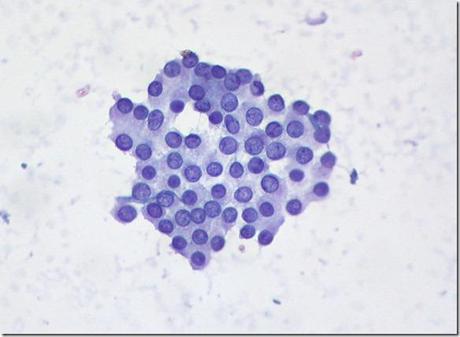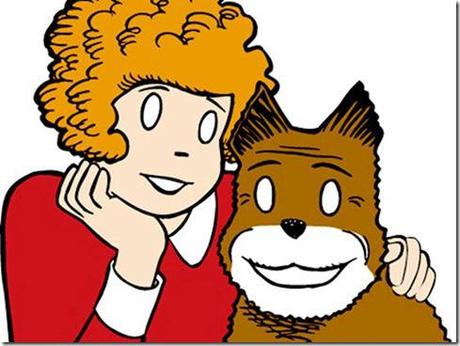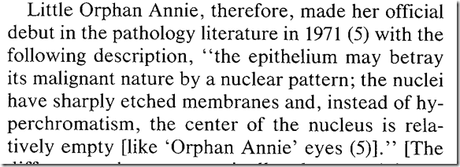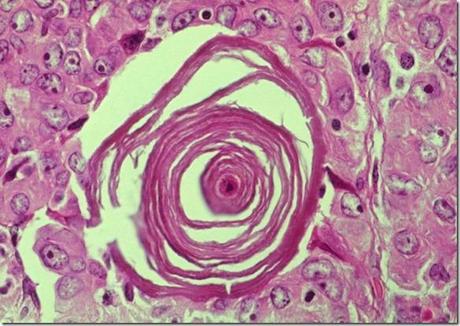One of the classic histopathological signs that we read of in Pathology quite often is theOrphan Annie Eye nucleus seen in Papillary carcinoma of the thyroid. This odd name has an interesting history behind it. One that dates back to two popcult references – one at the fag end of the 1800s and one that started slightly later, in 1924.
The Bethesda guidelines for cytology of malignant papillary thyroid carcinoma declare the nuclear criteria as:
Nuclear features: large nuclei, oval or molded, irregular membranes, nuclear clearing (Orphan Annie eye nuclei) with powdery chromatin, nuclear grooves, one or more marginally placed micronucleoli, nuclear crowding/overlapping

Papillary Carcinoma of the Thyroid, Fine Needle Aspirate, Pap Stain.
Image Credit: Dr. Ed Uthman via his Flickr stream. Follow him on Twitter
The typical description of the nuclei of these cells are quite a match for the empty eyes of a popular comic character called Orphan Annie. Harold Gray created the Little Orphan Annie daily strip. It debuted in 1924 and climbed to rank number one on a poll by Fortune in 1937. Gray ran the strip till his death in 1968, but the strip still kept running thereafter. Unfortunately, the popularity of the strip kept waning after the death of its creator, Gray. And finally it was cancelled on June 13, 2010 when it was running in only 20 newspapers.

The nomenclature was coined by Dr. Nancy Warner (Hastings Professor of Pathology, Emeritus, USCLA). According to Dr. Warner, the distinctive appearance of the nuclei were first noted by Nathan Friedman who wanted to call them “hot eyes” suggesting the eyes of Martha Scott, a star of the bygone era of “motion pictures”. Obviously, I had never heard of Martha Scott, and the couplet “hot eyes” obviously irked my interest, so I went around looking for her, and as a result of my extensive search, I must say NF was so true about the name he had proposed:

However Dr. Warner decided to stomp on Friedman’s idea and went ahead and named it in the honor of the vacant eyes of the cartoon character Annie. Here is what she said in a correspondence about the “official debut” of the nomenclature:

The other cultural connotation associated with this name is a little indirect. Basically, the name of the Orphan Annie of the comic strip is taken from james Whitcombe Riley’s poem “Little Orphant Annie” (originally titled The Elf Child, the poet changed the name of the poem in its third reprint) which was published in 1885. A lyrical ditty base on Mary Alice Smith, an orphan who lived in Riley’s home during his childhood, this is a four stanza poem in which Annie tells the household kids stories about being good or else face the wrath of the goblins. This poem is a brilliantly rhythmic one, made to be read out loud, and in rhythm. Here is Charles Edward reading the 1885 poem “Little Orphant Annie” by James Whitcomb Riley (audio via Wikimedia).
The poem, for the advantage of those who, like me, are unable to follow the Hoosier dialect the poem runs on in:
Little Orphant Annie
- Little Orphant Annie’s come to our house to stay,
- An’ wash the cups an’ saucers up, an’ brush the crumbs away,
- An’ shoo the chickens off the porch, an’ dust the hearth, an’ sweep,
- An’ make the fire, an’ bake the bread, an’ earn her board-an’-keep;
- An’ all us other children, when the supper-things is done,
- We set around the kitchen fire an’ has the mostest fun
- A-list’nin’ to the witch-tales ‘at Annie tells about,
- An’ the Gobble-uns ‘at gits you
- Ef you
- Don’t
- Watch
- Out!
- Wunst they wuz a little boy wouldn’t say his prayers,–
- An’ when he went to bed at night, away up-stairs,
- His Mammy heerd him holler, an’ his Daddy heerd him bawl,
- An’ when they turn’t the kivvers down, he wuzn’t there at all!
- An’ they seeked him in the rafter-room, an’ cubby-hole, an’ press,
- An’ seeked him up the chimbly-flue, an’ ever’-wheres, I guess;
- But all they ever found wuz thist his pants an’ roundabout:–
- An’ the Gobble-uns ‘ll git you
- Ef you
- Don’t
- Watch
- Out!
- An’ one time a little girl ‘ud allus laugh an’ grin,
- An’ make fun of ever’ one, an’ all her blood-an’-kin;
- An’ wunst, when they was “company,” an’ ole folks wuz there,
- She mocked ‘em an’ shocked ‘em, an’ said she didn’t care!
- An’ thist as she kicked her heels, an’ turn’t to run an’ hide,
- They wuz two great big Black Things a-standin’ by her side,
- An’ they snatched her through the ceilin’ ‘fore she knowed what she’s about!
- An’ the Gobble-uns ‘ll git you
- Ef you
- Don’t
- Watch
- Out!
- An’ little Orphant Annie says, when the blaze is blue,
- An’ the lamp-wick sputters, an’ the wind goes woo-oo!
- An’ you hear the crickets quit, an’ the moon is gray,
- An’ the lightnin’-bugs in dew is all squenched away,–
- You better mind yer parunts, an’ yer teachurs fond an’ dear,
- An’ churish them ‘at loves you, an’ dry the orphant’s tear,
- An’ he’p the pore an’ needy ones ‘at clusters all about,
- Er the Gobble-uns ‘ll git you
- Ef you
- Don’t
- Watch
- Out!
What has made the name more significant is the fact that in the comic strips, little orphan Annie had a pet dog called Sandy. Another histopathological sign of papillary carcinoma of the thyroid are Psammoma bodies. Psammoma bodies are whorled collection of calcium that builds up within certain neoplasms. The presence of Psammoma bodies is one of the points of distinction between follicular and papillar carcinoma of the thyroid gland. Now the word Psammoma is derived from the Greek word psammos which means SAND, which is almost similar to the name of Annie’s accompanying dog. Coincidence? probably not!

One has to praise the ingenuity and the imagination of Dr. Warner for coming up with such an apt name for the nearly diagnostic sign which has indeed stuck on in pathology!
Read More:
1. Wikipedia: Orpha Annie Eye
2. Wikipedia: Little Orphant Annie
3. Wikipedia: Psammoma Body
4. DeLillis RA. Orphan Annie Eye Nuclei: A Historical Note. AJSP. 1993; 17(10):1067-(Letters to the Editor)
5. Hapke MR, Dehner LP. The optically clear nucleus. A reliable sign of papillary carcinoma of the thyroid? Am J Surg Pathol. 1979 Feb;3(1):31-8. PubMed PMID: 534382.
6. Dominguez-Malagon HR, Szymanski-Gomez JJ, Gaytan-Garcia SR. Optically clear and vacuolated nuclei. Two useful signs for the transoperative diagnosis of papillary carcinoma of the thyroid. Cancer. 1988 Jul 1;62(1):105-8. PubMed PMID: 3289724.
7. Aakif Ullah Khan, Saif ul Haque, Syed Qaiser Shah, Javaid Irfan. Orphan Annie Eyes: from Comics to Clinics International Journal of Pathology; 2011; 9(1):47-48 PDF
Image Credits:
Orphan Annie and her Dog Sandy: Super Hero Stuff
Martha Scott: Classic Actresses
Psammoma Body in Papillary Carcinoma Thyroid: Wikimedia
